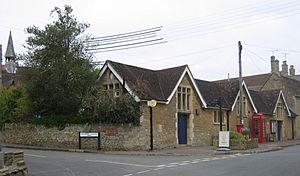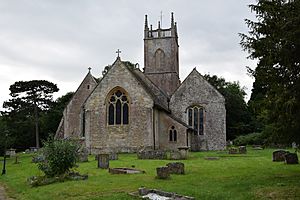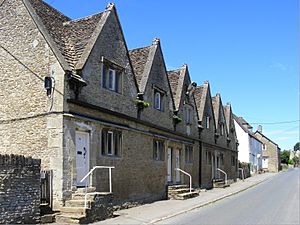Kington St Michael facts for kids
Quick facts for kids Kington St Michael |
|
|---|---|
 South end of the village |
|
| Population | 704 (in 2011) |
| OS grid reference | ST902776 |
| Civil parish |
|
| Unitary authority |
|
| Ceremonial county | |
| Region | |
| Country | England |
| Sovereign state | United Kingdom |
| Post town | Chippenham |
| Postcode district | SN14 |
| Dialling code | 01249 |
| Police | Wiltshire |
| Fire | Wiltshire |
| Ambulance | Great Western |
| EU Parliament | South West England |
| UK Parliament |
|
Kington St Michael is a village and a local area (called a civil parish) located about 3 miles (4.8 km) north of Chippenham in Wiltshire, England. In 2011, about 704 people lived there.
Contents
Where is Kington St Michael Located?
Kington St Michael is close to the A350 road, which connects Chippenham to the M4 motorway. The village is about 0.7 miles (1.1 km) west of the A350 and 1.5 miles (2.4 km) southwest of the M4's junction 17.
The village mainly stretches along its main street, running from southeast to northwest. At one end, a road called Honey Knob Hill leads out into the countryside towards Grittleton. West of the village is Easton Piercy, which used to be a small settlement with its own chapel. Today, it is mostly a farm with a few houses.
A Brief History of Kington St Michael
People have lived in the Kington St Michael area since the New Stone Age and Bronze Age periods. The first time the settlement was named was around AD 934, when it was called "Kington." Both Kington (Chintone) and Easton (Estone) were small places when they were recorded in the 1086 Domesday Book survey.
Later, the village was known as "Kington Minchin" because of the Kington St. Michael Priory (a type of monastery) nearby. In 1279, it became "Kington St Michael" when the local church was dedicated to St Michael.
Land Ownership and the Snell Family
In the 900s, kings gave land in the area to Glastonbury Abbey. After the Dissolution of the Monasteries (when monasteries were closed down) in 1544, Nicholas Snell bought Kington Michael manor from the Crown. The Snell family gathered a lot of land near the Wiltshire–Somerset border. After Nicholas's son, John, bought Easton Piercy manor in 1575, they owned almost the entire area.
The manor house built by Nicholas stayed in the family until 1651. When the current manor house was built in 1863, some parts from the Snell's old house were used again. This included the Snell family crest, which can be seen over a window.
Village Life and Economy
A market cross used to be next to the Priory, where basic foods were sold. There was also a special fair held around Michaelmas (September 29th) known for its "ale and geese."
For many years, farming was the main activity in the village. However, there is also some evidence of a small textile industry. Around 1760, the road from Chippenham to Malmesbury (now the A350) became a turnpike road. This meant people had to pay to use it, but it also brought more traffic and business to Kington. By the late 1700s, the village had "tailors, two blacksmiths and a carpenter." It also had a slaughterhouse, a malthouse (for making malt for brewing), and a pub. By 1851, even more types of jobs were available in the village.
In 1971, a small area of 15 acres (6.1 hectares) was moved from Kington St Michael to the nearby parish of Chippenham Without.
The Parish Church of St Michael
The Church of England parish church of St Michael is a very old and important building, listed as Grade II*. It is built from stone and has a tower at the west end and a small chancel (the area around the altar). In between are the nave (the main part of the church) and wide aisles on the north and south sides, each with a gabled roof.
Church History and Architecture
There are signs that a church stood here in the 12th century, seen in the wide arch leading to the chancel and in the door frames of the south entrance. These have carved decorations. The chancel itself was built in the 13th century, and its windows and a special basin (called a piscina) show the style of that time. The south aisle also dates from this period.
The tower and spire of the church fell down in a storm in 1703. The new tower was built with a decorative top and tall spires. The north aisle was rebuilt in 1755, keeping a similar style to the older parts.
A lot of work was done on the church in the 1800s. The front of the porch, the vestry (a room for clergy), and most of the roofs were added then. The reredos (a screen behind the altar) and some windows are also from this time. In 1857–58, the church was restored by John Henry Hakewill.
Stained Glass and Memorials
Several windows in the church have stained glass from the 1800s. The brightly colored east window of the south aisle, from 1857, remembers two famous historians who were born in the area: John Aubrey and John Britton.
The stone font (used for baptisms) is round and sits on a short base. The church tower has a set of six bells, which were made in 1726. The lychgate (a covered gateway to the churchyard) at the main entrance was built in 1917. It was a memorial to Herbert Prodgers of Kington Manor.
In the churchyard, there are several old tombs from the 1700s and early 1800s. These are also listed as important historical items because of their excellent quality.
Changes to the Parish
The old parish used to include Langley, which is now Kington Langley. Until 1670, there was a small chapel there. A new church was built in Kington Langley in 1857. In 1865, this new church became its own separate church area. Today, St Michael's church is part of the Bybrook Benefice, which is a group of ten churches in the countryside.
Other Interesting Buildings in Kington St Michael
Priory Manor, located a short distance west of the village, is a Grade II* listed building. It includes parts of the original 13th-century priory, such as the prioress's living area and guest hall. These formed the west side of the cloister (a covered walkway). The refectory (dining hall) from the south side is also part of the building. Over the years, work in the 1400s, 1500s, and 1600s shaped it into the L-shaped house we see today.
The former rectory, on Stubbs Lane, is thought to date back to 1715. It is also L-shaped and has a front made of smooth stone. Kington Manor, west of the church, was rebuilt in the Cotswold style in 1863–64 for Herbert Prodgers.
Near the south end of the main street, Home Farmhouse dates from the late 1600s or early 1700s. Further north, a row of six almshouses (houses for poor people) was built in 1675 for Isaac Lyte.
Manor Farmhouse at Easton Piercy is dated 1631. The older part of this house is what remains of a larger manor house that once belonged to the Lyte family.
Village Amenities and Services
Kington St Michael Club opened in 1923. It was improved in the late 1980s and renovated again in 2003, providing a place for community activities.
After the local Post Office closed in 2008, the village opened a community-owned shop. It is run by volunteers from a part of the village hall and sells local produce and alcoholic drinks.
The village has a primary school called Kington St Michael Church of England School. It is a voluntary controlled school, meaning it is run by the local authority but has a religious character. The school serves children from the village and parts of north Chippenham. It has about 118 pupils and was rated "Outstanding" by Ofsted in 2014. The current school building was built in 1978, replacing an older school from 1868, which is now used as the village hall.
Kington St Michael also has a public house (pub) called the Jolly Huntsman. It dates back to the 1700s, when it was known as the White Horse Brewery and brewed its own beer. Today, it is a free house, meaning it can sell any brand of beer. The pub has been listed in the CAMRA Good Beer Guide since 2006 and was named "Regional Pub of the Year" in 2010.
Notable People from Kington St Michael
Many interesting people have connections to Kington St Michael:
- Nicholas Snell (died 1577) was a landowner and a member of parliament (MP). He lived at Kington Manor, as did his son John (died 1587), who was also an MP for a short time.
- John Aubrey (1626–1697), a famous historian and archaeologist, was born at Easton Piercy.
- John Britton (1771–1857), another well-known historian, was born in the parish.
- Charles Pepys, 8th Earl of Cottenham (1948–2000) was a cricketer and horse rider who lived at Priory Manor.
- Jeremy Corbyn (born 1949), a Member of Parliament and former leader of the Labour Party, lived in the village until he was seven years old.
- Piers Corbyn (born 1947), a weather forecaster and Jeremy's older brother, also grew up in the village.
See also
 In Spanish: Kington St Michael para niños
In Spanish: Kington St Michael para niños





